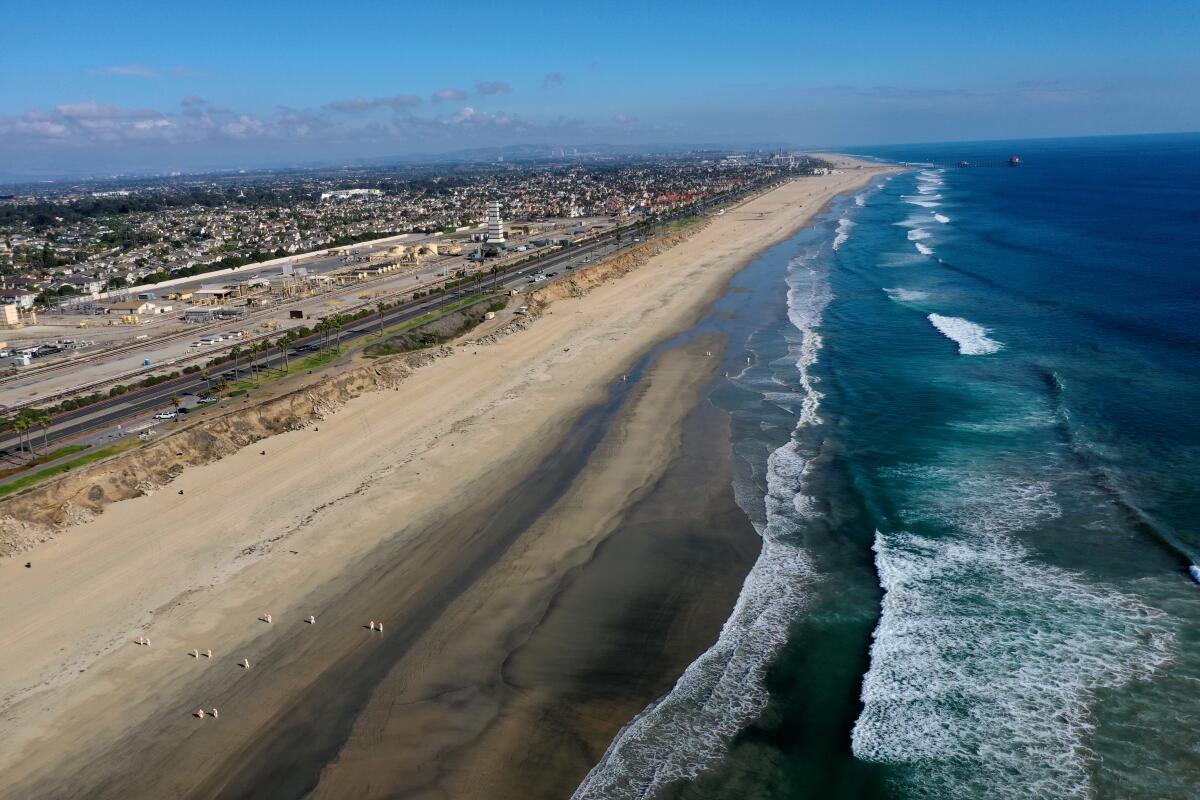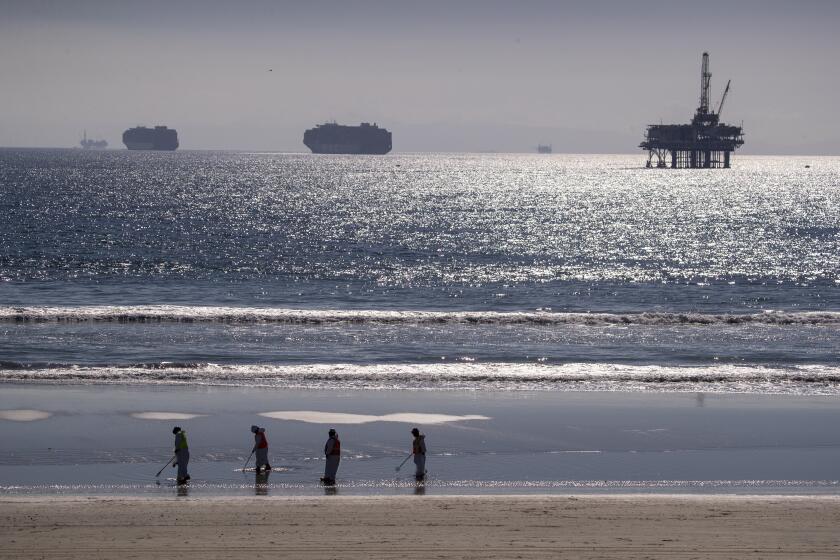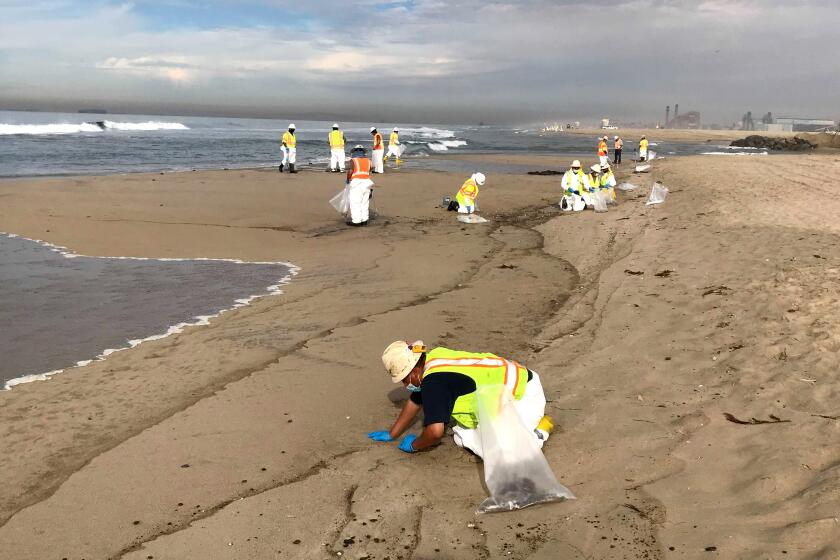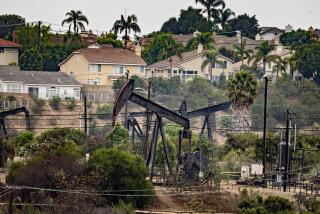Enough is enough. It’s time to phase out offshore oil production in California

- Share via
SACRAMENTO — If you’ve been around for enough Earth spins, you’ve seen the world turn upside down — especially concerning Californian’s attitude on oil production.
Up until the 1969 Santa Barbara oil spill that spewed 3 million gallons of crude into the ocean and killed 3,500 sea birds, oil was royalty along the Southern California coast. Now it’s reviled as a messy nuisance that has overstayed its welcome.
Both attitudes were — and are — justified.
Oil helped build Southern California’s 20th-century economy. But in the 21st century, offshore production is worth far less than its environmental cost.
That’s beside the evidence that the fossil fuel is a proven global menace, speeding climate change and contributing to devastating drought, flooding and wildfires.
Now we’ve got another ugly offshore oil spill that has poured an estimated 144,000 gallons of crude oil into the waters off Orange County, killing fish and birds and smudging beaches with goo.
This time, a ship’s anchor is suspected of having ruptured a 50-foot-deep pipeline carrying oil from federal waters to the Port of Long Beach near the Queen Mary.
OK, maybe it’s not the oil company’s fault. Maybe it’s a ship’s for dropping anchor where it shouldn’t have. If so, make it pay big. But there are lots of ships off the SoCal coast, and they belong there. Oil pipes and platforms don’t necessarily. They’re shipping hazards.
Enough is enough. Offshore oil production — not just well drilling — should be phased out.
The Coast Guard investigates a cargo vessel that was in the area before a pipeline break off the Orange County coast spilled 144,000 gallons of oil.
Freshman state Sen. Dave Min (D-Irvine), who represents Huntington Beach, the slick’s primary victim, says he’s looking into introducing legislation to ban all oil production in California waters. He’s also urging Congress to ban it in federal waters.
“The amount of oil that’s produced is a drop in the bucket,” Min says. If it were left in the ocean floor, “I don’t think it would impact gas prices at all. It’s so de minimis compared to the destruction of beaches caused by oil spills every five or 10 years, not to mention the damage to wildlife and habitat. It’s long past time to end this.”
The state of California receives roughly $90 million annually from offshore oil and gas leases. But this isn’t even a drop in the state’s bucket — at least $240 billion total revenue is expected this year.
The Western States Petroleum Assn., however, says state and local governments garner about $22 billion annually from all oil and gas operations in California. And oil companies also pay $26 billion in wages and benefits, the trade association claims.
State government could collect a lot more from oil if it ever decided to tax the crude as it’s pumped from the ground or ocean floor. California is the only major oil-producing state that does not impose a tax on oil severance — or extraction or depletion, choose your word. But the companies do pay local property taxes on underground reserves.
Why doesn’t California levy a severance tax? The oil lobby, partnered with labor, has beaten back that legislation for decades.
I asked Secretary Wade Crowfoot of the state Natural Resources Agency.
“It’s not a focus of ours,” he replied, referring to Gov. Gavin Newsom’s administration. “It would impact the cost of gasoline. Most Californians still rely on gasoline to move around in cars.”
But it would certainly reduce oil production in California, a long-range Newsom goal, I noted.
“If we only focused on extraction and not demand, we’d be missing the boat,” Crowfoot said. “We’d still be dealing with oil from other places.”
A major oil spill off the coast of Huntington Beach, Calif., washed up on nearby Orange County beaches, killing fish and birds and threatening local wetlands.
He noted that Newsom has decreed that there’ll be no new fossil fuel-burning cars sold in California starting in 2035 and all oil production will end by 2045. Of course, Newsom will be long gone from Sacramento by then, so his ambitious edicts could be reversed by a future governor.
“That’s fair,” Crowfoot said of the caveat. “But we think it sends a signal to the marketplace. And it’s why California is attracting over half the country’s investment in clean energy.”
In California waters within three miles of the coast, there are 11 oil leases and three operating platforms off Orange County: Emma, Eva and Esther.
In the Santa Barbara Channel, the state is decommissioning Rincon Island and has just finished plugging its 75 wells. It’s also starting to decommission Platform Holly and its 30 wells.
But getting rid of all oil operations in California waters may be practically and legally impossible, Crowfoot says.
“There are real complexities with terminating leases,” he says. “There are health and safety concerns if companies simply go bankrupt and leave the state with the responsibility.”
Jennifer Lucchesi, executive officer of the State Lands Commission, which regulates offshore oil in California waters, estimates it will cost the state treasury $500 million to decommission Platform Holly.
It’s well worth it.
U.S. Sen. Dianne Feinstein hopes to insert into the embattled $3.5-trillion infrastructure bill that’s stymied in the House a permanent ban on all new drilling in federal waters off California, Oregon and Washington.
“Californians have made it clear: We don’t want oil drilling off our coast,” she said in a statement.
It’s time to make our offshore waters a dry hole for oil producers.
More to Read
Sign up for Essential California
The most important California stories and recommendations in your inbox every morning.
You may occasionally receive promotional content from the Los Angeles Times.













